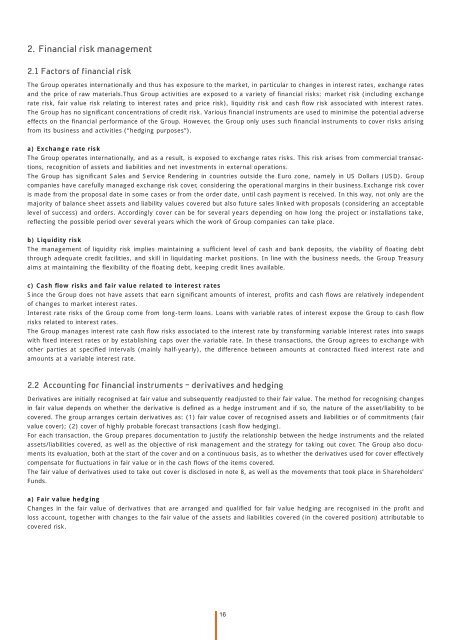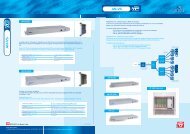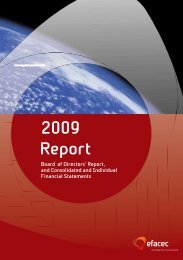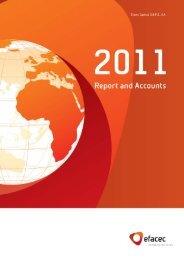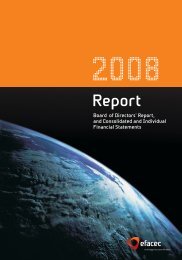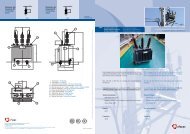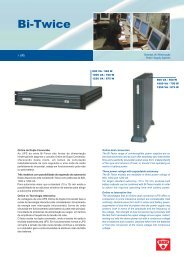Notes to the consolidated financial statements - Efacec
Notes to the consolidated financial statements - Efacec
Notes to the consolidated financial statements - Efacec
You also want an ePaper? Increase the reach of your titles
YUMPU automatically turns print PDFs into web optimized ePapers that Google loves.
2. Financial risk management<br />
2.1 Fac<strong>to</strong>rs of <strong>financial</strong> risk<br />
The Group operates internationally and thus has exposure <strong>to</strong> <strong>the</strong> market, in particular <strong>to</strong> changes in interest rates, exchange rates<br />
and <strong>the</strong> price of raw materials.Thus Group activities are exposed <strong>to</strong> a variety of fi nancial risks: market risk (including exchange<br />
rate risk, fair value risk relating <strong>to</strong> interest rates and price risk), liquidity risk and cash fl ow risk associated with interest rates.<br />
The Group has no signifi cant concentrations of credit risk. Various fi nancial instruments are used <strong>to</strong> minimise <strong>the</strong> potential adverse<br />
effects on <strong>the</strong> fi nancial performance of <strong>the</strong> Group. However, <strong>the</strong> Group only uses such fi nancial instruments <strong>to</strong> cover risks arising<br />
from its business and activities (“hedging purposes”).<br />
a) Exchange rate risk<br />
The Group operates internationally, and as a result, is exposed <strong>to</strong> exchange rates risks. This risk arises from commercial transactions,<br />
recognition of assets and liabilities and net investments in external operations.<br />
The Group has signifi cant Sales and Service Rendering in countries outside <strong>the</strong> Euro zone, namely in US Dollars (USD). Group<br />
companies have carefully managed exchange risk cover, considering <strong>the</strong> operational margins in <strong>the</strong>ir business.Exchange risk cover<br />
is made from <strong>the</strong> proposal date in some cases or from <strong>the</strong> order date, until cash payment is received. In this way, not only are <strong>the</strong><br />
majority of balance sheet assets and liability values covered but also future sales linked with proposals (considering an acceptable<br />
level of success) and orders. Accordingly cover can be for several years depending on how long <strong>the</strong> project or installations take,<br />
refl ecting <strong>the</strong> possible period over several years which <strong>the</strong> work of Group companies can take place.<br />
b) Liquidity risk<br />
The management of liquidity risk implies maintaining a suffi cient level of cash and bank deposits, <strong>the</strong> viability of fl oating debt<br />
through adequate credit facilities, and skill in liquidating market positions. In line with <strong>the</strong> business needs, <strong>the</strong> Group Treasury<br />
aims at maintaining <strong>the</strong> fl exibility of <strong>the</strong> fl oating debt, keeping credit lines available.<br />
c) Cash fl ow risks and fair value related <strong>to</strong> interest rates<br />
Since <strong>the</strong> Group does not have assets that earn signifi cant amounts of interest, profi ts and cash fl ows are relatively independent<br />
of changes <strong>to</strong> market interest rates.<br />
Interest rate risks of <strong>the</strong> Group come from long-term loans. Loans with variable rates of interest expose <strong>the</strong> Group <strong>to</strong> cash fl ow<br />
risks related <strong>to</strong> interest rates.<br />
The Group manages interest rate cash fl ow risks associated <strong>to</strong> <strong>the</strong> interest rate by transforming variable interest rates in<strong>to</strong> swaps<br />
with fi xed interest rates or by establishing caps over <strong>the</strong> variable rate. In <strong>the</strong>se transactions, <strong>the</strong> Group agrees <strong>to</strong> exchange with<br />
o<strong>the</strong>r parties at specifi ed intervals (mainly half-yearly), <strong>the</strong> difference between amounts at contracted fi xed interest rate and<br />
amounts at a variable interest rate.<br />
2.2 Accounting for <strong>financial</strong> instruments – derivatives and hedging<br />
Derivatives are initially recognised at fair value and subsequently readjusted <strong>to</strong> <strong>the</strong>ir fair value. The method for recognising changes<br />
in fair value depends on whe<strong>the</strong>r <strong>the</strong> derivative is defi ned as a hedge instrument and if so, <strong>the</strong> nature of <strong>the</strong> asset/liability <strong>to</strong> be<br />
covered. The group arranges certain derivatives as: (1) fair value cover of recognised assets and liabilities or of commitments (fair<br />
value cover); (2) cover of highly probable forecast transactions (cash fl ow hedging).<br />
For each transaction, <strong>the</strong> Group prepares documentation <strong>to</strong> justify <strong>the</strong> relationship between <strong>the</strong> hedge instruments and <strong>the</strong> related<br />
assets/liabilities covered, as well as <strong>the</strong> objective of risk management and <strong>the</strong> strategy for taking out cover. The Group also documents<br />
its evaluation, both at <strong>the</strong> start of <strong>the</strong> cover and on a continuous basis, as <strong>to</strong> whe<strong>the</strong>r <strong>the</strong> derivatives used for cover effectively<br />
compensate for fl uctuations in fair value or in <strong>the</strong> cash fl ows of <strong>the</strong> items covered.<br />
The fair value of derivatives used <strong>to</strong> take out cover is disclosed in note 8, as well as <strong>the</strong> movements that <strong>to</strong>ok place in Shareholders’<br />
Funds.<br />
a) Fair value hedging<br />
Changes in <strong>the</strong> fair value of derivatives that are arranged and qualifi ed for fair value hedging are recognised in <strong>the</strong> profi t and<br />
loss account, <strong>to</strong>ge<strong>the</strong>r with changes <strong>to</strong> <strong>the</strong> fair value of <strong>the</strong> assets and liabilities covered (in <strong>the</strong> covered position) attributable <strong>to</strong><br />
covered risk.<br />
16


